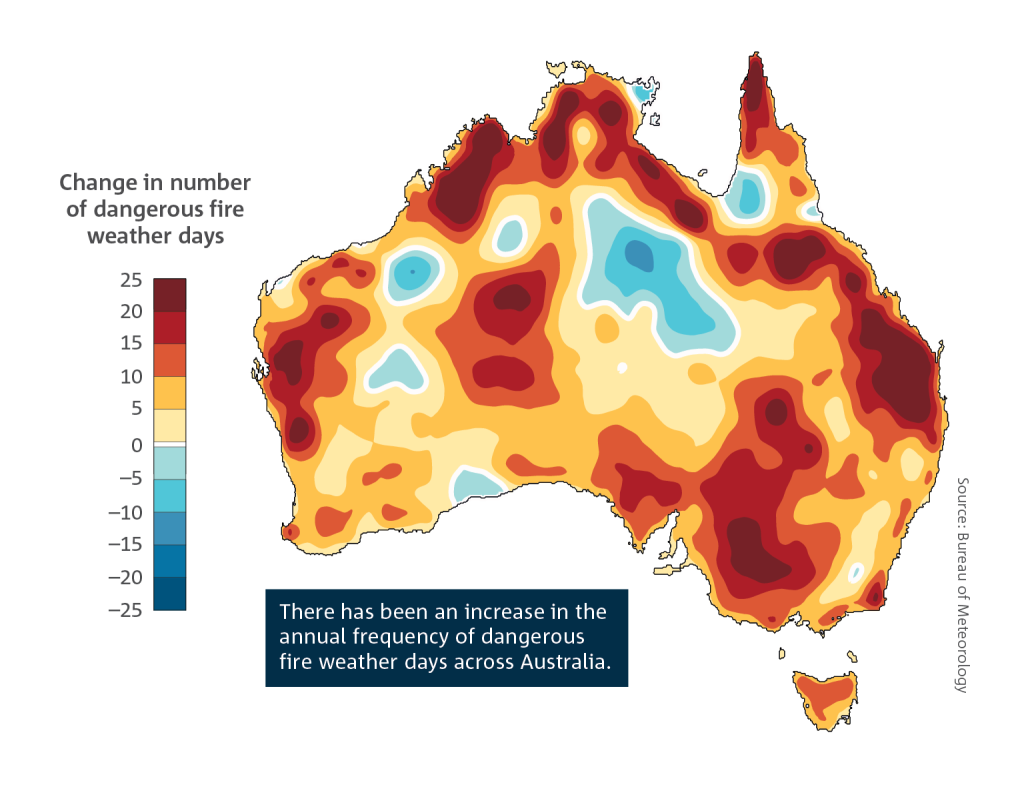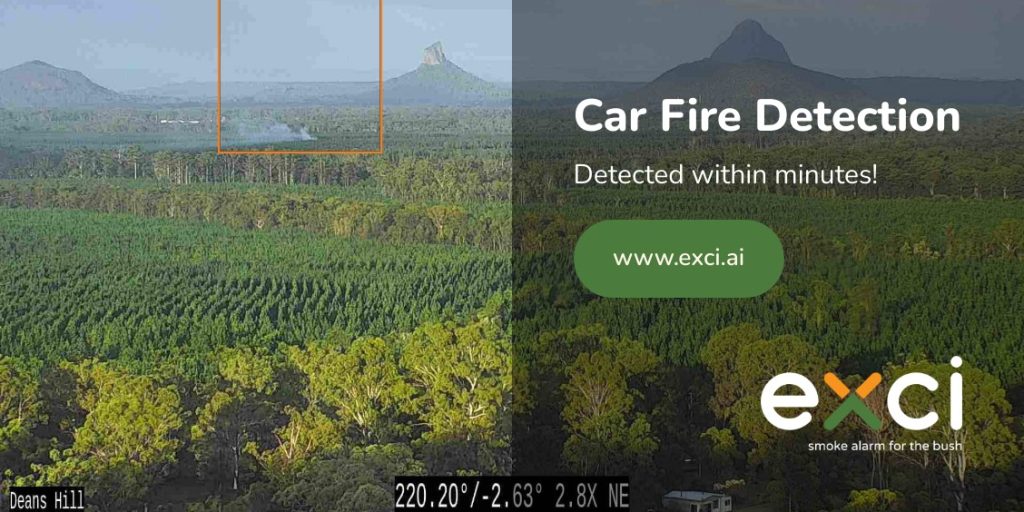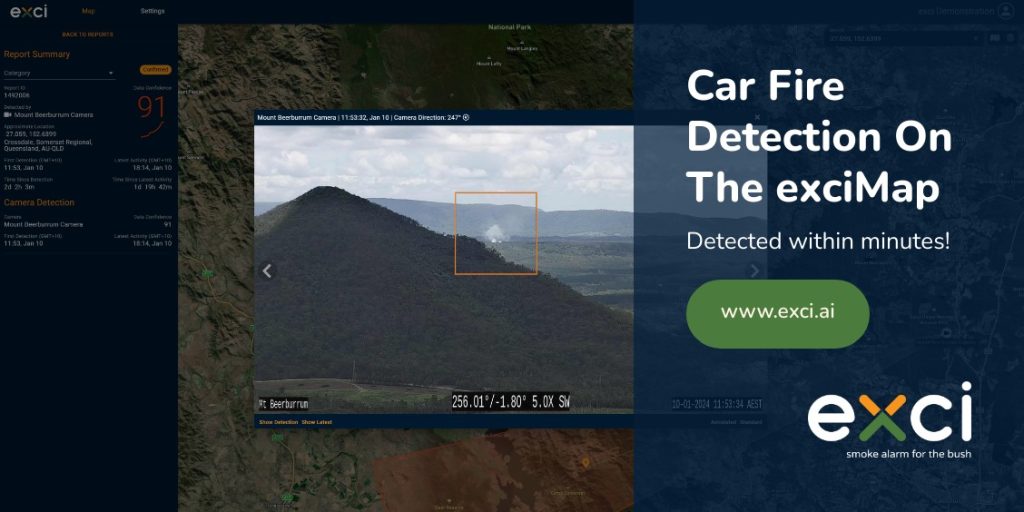Australia is one of the most fire-prone countries worldwide. While fire is a natural mechanism for maintaining biodiversity and supporting ecosystems, not all fires are beneficial. Amidst the devastating 2023-24 Australian bushfire season, where over 70 million hectares succumb to the relentless flames, a troubling revelation surfaces. Allegedly, up to 18,000 bushfires annually are marked as “suspicious or malicious in Australia.
Blaming arsonists is a convenient way, especially for politicians, to deflect attention from the larger issue of climate change’s role in exacerbating disasters. The truth, however, is more nuanced. The fact is that the climate has warmed, increasing the frequency and intensity of bushfires. Arsonists worsen this situation, but they are not the main problem.
Regardless of whether arsonists or climate change are responsible for igniting bushfires, innovative solutions exist to mitigate their impact. This blog post will examine the evidence to determine whether arson is the primary cause of the bushfire crisis. We will explore the distinctions between firesetting behaviour and the criminal act of arson, delve into the intricate motivations driving arson, and ultimately demonstrate how exci’s advanced AI-powered wildfire/bushfire detection technology has effectively mitigated the effects of both intentional and climate-induced wildfires
Understanding the Role of Arsonists
Human-caused ignitions, ranging from reckless behaviour to deliberate acts of arson, significantly contribute to the bushfire crisis. However, widely cited statistics referring to the article ‘Understanding bushfire: trends in deliberate vegetation fires in Australia’ by Bryant C. (2008) attributing 37 to 50% of fires to arsonists are misleading. The report, more than a decade old, analysed only fires that were assigned a cause — 13% of those fires were deliberate and 37% were suspicious. It doesn’t account for at least 40% of all fires that weren’t assigned a cause. These figures often encompass vegetation fires, including minor incidents like backyard fires, which may not pose significant dangers. Even Bryant C cautioned against misrepresenting the data, emphasising the role of natural causes like lightning in bushfires, especially during adverse fire seasons. She also emphasised that the report studied deliberately lit vegetation fires but not bushfires vs arson.
Who is to blame? Climate change, Arsonists, or Both?
Contrary to the simplistic narrative of arson versus climate change, the evidence suggests a multifaceted problem requiring a nuanced approach. Human behaviour, combined with environmental factors, determines the occurrence and severity of bushfires. While addressing deliberate fire-setting is crucial, broader initiatives to mitigate climate change’s impacts are equally vital. Nguyen et al. (2020) conducted a comprehensive analysis of the 2020 bushfire season, attributing only 1% of New South Wales (NSW) land and 0.03% of Victoria to arson. However, the issue of arson has become politicised, perpetuated by misinformation and scapegoating on social media platforms. Blaming arsonists deflects attention from climate change’s role in exacerbating disasters, highlighting the collective responsibility to prevent bushfires.
Ultimately, Bryant emphasises the need for collective awareness and action. All individuals must recognise the potential consequences of their actions and adjust their behaviours accordingly to reduce the risk of bushfires. This includes addressing deliberate fire-setting and mitigating the broader impacts of climate change on fire weather conditions. Only through a comprehensive and collaborative approach can we effectively manage and minimise the threat of bushfires in Australia’s increasingly challenging environment.
 Map by BOM – Increased number of dangerous bushfires
Map by BOM – Increased number of dangerous bushfires
Distinguishing Arson, Firesetting, and Pyromania
Arson, firesetting, and pyromania are distinct terms that refer to different types of deliberate fire-related behaviour. Understanding these differences is crucial for clear discussions about fire-related incidents and disorders.
Arson
Arson is a criminal act involving intentionally and unlawfully setting fire to property, structures, or landscapes with the intent to cause damage, harm, or destruction. Convicted perpetrators may face severe legal consequences, including imprisonment. The severity of charges depends on the extent of damage, the presence of injuries, and the motives behind the act.
Firesetting
Firesetting is a broader term that includes any deliberate act of starting a fire, regardless of criminal intent. It encompasses both intentional and non-malicious fire-setting activities. The legal consequences vary depending on the nature and intent of the act. Firesetting is more common among children and adolescents.
Pyromania
Pyromania is an impulse control disorder characterised by an inability to resist deliberately starting fires. Those with pyromania experience tension, anxiety, or arousal relieved by setting fires, leading to satisfaction or relief. It falls under the disruptive, impulse-control, and conduct disorders category, contributing to aggressive behaviour towards people or property.
To diagnose pyromania, specific criteria must be met, including
- deliberate fire-setting on multiple occasions,
- heightened emotional state before starting a fire,
- obsession with fire,
- pleasure or gratification from fire-related activities,
- Fire setting occurs without intent for monetary profit, political expression, concealment of crime, revenge, or improving living conditions. It’s not driven by delusions, hallucinations, or impaired judgment due to neurocognitive disorders, intellectual disability, or substance intoxication, and
- The absence of explanations for other psychiatric disorders.
Pyromania is rare, with only a small percentage of arson cases meeting its criteria. The causes of pyromania remain unclear, but potential factors include other psychiatric disorders, hereditary components, imbalances in brain chemicals, stressors like significant losses or child abuse, and triggers associated with fire-setting and positive feelings. Certain risk factors, such as being male, below-average intelligence, mood disorders, mistreatment in childhood, attention deficit hyperactivity disorder (ADHD), and family stress, have been linked to pyromania.
What makes an Arsonist?
 Image source: Arson by EdenMoon via pixabay
Image source: Arson by EdenMoon via pixabay
Arsonists exhibit a range of characteristics, and their motivations vary widely. Understanding these factors is crucial for developing targeted interventions and preventive measures to mitigate arson incidents. A 1994 research study on serial and shipboard arsonists conducted by the Arson and Bombing Investigative Services Subunit (ABIS) revealed significant findings regarding their demographics, criminal histories, behaviours, and methods.
Demographically, the majority of serial arsonists were young white males, with many under 27 at the time of interviews. Most had poor marital adjustment and educational attainment, with only a small percentage completing high school.
Many serial arsonists had prior felony arrests, often multiple, and a significant proportion also had misdemeanour arrest records. They often spent substantial time in various institutions such as orphanages, foster homes, and mental health facilities. Psychological instability was prevalent, with a quarter reporting prior suicide attempts.
Firesetting behaviour among serial arsonists peaked between ages 14 and 18, with a notable decrease between ages 19 and 21, followed by an increase for those aged 30 or older.
Regarding methods, arsonists typically gained access to target structures through open entryways or by breaking in. Accomplices were involved in about 20% of cases, with solo arsonists setting significantly more fires. Common accelerants like gasoline and matches or lighters were used, and many arsonists left items at the scene or removed valuables before igniting fires. After setting fires, some remained at the scene, while others observed from a distance or did not return. While most set only one fire in a location, some returned to set multiple fires in the same place.
Recent studies show that arson is predominantly committed by men, with women accounting for about 15% of incidents. However, despite their lower representation, Swedish crime statistics indicate that women make up a notable portion of arson convictions, sometimes exceeding men in specific contexts.
Now that we understand arsonists’ demographic and behavioural patterns, the question arises: what motivates individuals to commit arson?
Motives: Revenge, Vandalism, and Insurance Fraud
Arsonists often have clear motives, such as revenge, vandalism, or insurance fraud, beyond mental health disorders. Exploring these motives provides crucial insights into the diverse motivations behind arson, enabling targeted preventive measures and law enforcement strategies.
For Profit Arsonists
Some arsonists are driven by a calculated motive to profit from the destruction they cause. Their primary goal is monetary benefit, involving insurance fraud, property values, or business sabotage. Arson for profit often includes strategic planning, such as setting fires to collect insurance payouts, eliminate competition, or manipulate financial outcomes.
Revenge Arsonists
Revenge arsonists harbour deep-seated grievances, real or perceived, and turn to fire as retribution. They view fire as a tool for seeking justice or inflicting harm on those they believe have wronged them, creating a dangerous and destructive outlet for their emotions.
Extremist Ideology of Arsonists
Extremist arsonists use fire to advance their political, religious, or social beliefs. They target places of worship, community centres, or symbols associated with opposing ideologies. Driven by radical convictions, they are willing to inflict widespread damage and instil fear, making ideological motives a potent force behind certain acts of arson.
Serial Arsonists
Predominantly young white males (94 percent), serious arsonists have prior felony arrests, with many having spent time in various institutions. While juvenile offenders are common, many decrease or cease firesetting activities around age 19. However, those who continue become more frequent offenders, often using unsophisticated methods and returning to the crime scene.
Vandalism-Motivated Arsonists
Vandalism-motivated arson involves malicious or mischievous firesetting resulting in property damage. Perpetrators typically exhibit average or below-average intelligence, targeting familiar areas and leaving the scene without returning. While the frequency of offences remains stable over time, the severity of fires tends to increase.
Excitement-Motivated Arsonists
Excitement-motivated arsonists can be classified into several subtypes, such as thrill seekers, recognition seekers, sexual motivation, and attention seekers. The most common subtype, thrill seekers, exhibit a craving for excitement satisfied by firesetting, while recognition seekers desire praise for their efforts. Typically, these arsonists are white males with a history of institutionalisation, mental health issues, and felony arrests. They often target familiar areas, set fires using available materials, and display compulsive behaviour with little regard for consequences. The frequency and severity of their fires tend to increase over time.
Despite the diverse motives behind arson, the consequences are severe, affecting not only individuals but also entire communities and ecosystems.
Challenges Posed by Deliberately Ignited Bushfires
Intentionally lit bushfires present significant challenges for fire agencies, especially where forests, plantations, or hinterlands meet suburban zones, requiring coordinated efforts to prevent and mitigate their impact. Implementing targeted interventions and enhancing community engagement are essential for addressing this complex issue. Despite the dire outcomes—ranging from property damage to loss of life—arsonists frequently avoid detection and punishment due to the complexity of investigation and prosecution processes. In response, Australian fire services actively deploy strategies based on situational and community crime prevention methodologies.
Targeted Interventions
These efforts involve altering the physical landscape and enhancing community awareness to deter arson attempts. Targeted interventions, such as prescribed burns and prompt removal of potential ignition sources in identified hotspots, aim to reduce deliberate bushfires. These preventive measures mitigate immediate risks and alleviate resource strain, allowing fire agencies to prioritise tackling more severe blazes. So, what specific preventive measures are in place?
Public Awareness and Education Campaign
Public awareness and education campaigns are pivotal in preventing arson incidents by informing the community about the dangers and consequences linked with arson. These campaigns disseminate information through social media, pamphlets, workshops, and community events. Educating the public about the signs of arson, the significance of reporting suspicious activities, and arson’s devastating impact empowers individuals to participate actively in fire prevention. Moreover, by fostering responsibility and accountability within communities, these campaigns cultivate a culture intolerant of arson, ultimately decreasing the likelihood of arson incidents.
Adequate Fire Safety Measures in Public Space
It’s crucial to ensure adequate fire safety measures in public spaces to mitigate the risk of arson and minimise potential damage. This includes installing and maintaining fire detection and suppression systems like smoke detectors, fire alarms, sprinkler systems, and fire extinguishers in public buildings and facilities. Regular fire safety inspections and audits are also essential to identify and address any vulnerabilities or deficiencies in fire protection measures. Investing in robust fire safety infrastructure and protocols can deter potential arsonists and limit the spread of fires, thereby safeguarding public spaces and the individuals who use them.
Community Watch Programs: Building Resilience
Community watch programs are vital for preventing arson by fostering a network of vigilant community members who actively monitor their neighbourhoods for suspicious activities. These programs promote collaboration among residents, law enforcement, and fire departments to identify and address potential arson threats swiftly. Neighbourhood patrols, reporting mechanisms for suspicious behaviour, and community awareness campaigns empower communities to prevent arson incidents and cultivate pride in their neighbourhoods, reducing susceptibility to criminal activities. Additionally, these programs contribute to building a safer society through collective efforts and community engagement.
However, enhancing early wildfire detection is also crucial. Innovative technologies like exci’s advanced AI-powered wildfire/bushfire detection system offer promising solutions to combat arson and protect vulnerable areas.
The Role of exci’s AI-Wildfire/Bushfire Detection Technology in Arson
In wildfire management, timely detection and response are paramount in preventing small fires from escalating into large-scale disasters. exci’s advanced Wildfire Detection system, powered by advanced Artificial Intelligence (AI), plays a vital role not only in identifying natural wildfires, but also in combating the threat of arson. By leveraging cutting-edge technology, exci enhances wildfire management efforts and helps safeguard lives, property, and ecosystems.
Intentional or accidental fires pose a significant risk to industries such as plantations and forestry, potentially devastating years of investment in tree cultivation and management. Illegal activities like arson, vandalism, and abandoned vehicle fires exacerbate this threat.
With exci’s AI swiftly identifying and alerting customers to suspicious fire activity, we provide a crucial defense against arson-related incidents. We help protect our customers’ assets and livelihoods through real-time monitoring and rapid response capabilities, mitigating the potentially catastrophic consequences of deliberate fire ignition.
Below are two instances of vehicles intentionally set on fire and discarded within pine plantations of one of our customers. Thanks to our advanced AI, these incidents were detected within minutes of ignition.
 Car fire detection by exci’s Artificial Intelligence: Deans Hill
Car fire detection by exci’s Artificial Intelligence: Deans Hill
 Car fire detection by exci’s Artificial Intelligence: Mt Beerburrum
Car fire detection by exci’s Artificial Intelligence: Mt Beerburrum
By harnessing the power of artificial intelligence, exci’s system operates tirelessly, processing vast amounts of data with unmatched speed and accuracy. Trained on the world’s largest data set, exclusively owned by exci, our AI undergoes constant rigorous training. In the 2020/21 Californian season alone, exci’s AI analysed over one billion ground-based camera images and 500,000 satellite images.
exci’s system automatically identifies even small fires, such as those the size of a garden shed, within minutes of ignition, boasting an impressive near-zero false positive rate.
The effectiveness of exci’s AI-driven wildfire detection solution has been demonstrated through large-scale deployments. These include nearly 1,000 cameras deployed across California, covering more than 130 million acres across North America, and commercial installations in Australia spanning over 25 million acres of plantations and forestry.
Since its inception, exci’s system has detected more than 131,000 fires (as of October 2023), significantly mitigating economic, environmental, and social impacts on exci’s customers and their communities. With a continuous influx of data, exci remains at the forefront of wildfire detection technology, constantly refining its machine-learning models to enhance detection time and geospatial accuracy.
In conclusion, addressing the threat of arson requires a comprehensive approach that integrates technological innovation with community-driven initiatives.
Summary
Australia grapples with escalating bushfire frequency and intensity due to climate change and arson. The devastating 2023-24 bushfire season, ravaging over 70 million hectares, underscores this crisis’s urgency. While tempting to blame arson alone, the reality is complex.
Understanding the interplay of factors, including arson, is crucial in addressing the bushfire crisis comprehensively. Contrary to simplistic narratives, evidence suggests a multifaceted strategy is needed.
Human behaviour and environmental conditions shape bushfire occurrence and severity. While tackling deliberate fire-setting is vital, broader climate change mitigation efforts are equally crucial. Misinformation on social media platforms exacerbates the politicisation of arson, deflecting from climate change’s role.
exci’s AI-powered wildfire detection system offers hope. Leveraging advanced technology enhances wildfire management, detecting natural wildfires and arson promptly. Our exci system safeguards lives, property, and ecosystems, effectively mitigating bushfire threats.
A collaborative approach integrating technology with community-driven initiatives is key to managing bushfire risks. Together, we can minimise the impacts of intentional and climate-induced wildfires, ensuring safety and resilience for future generations.
by Gabrielle Tylor
exci – The Smoke Alarm for the Bush
AI-powered Wildfire/Bushfire Detection Technology
10 April 2024
Don’t let Hazardous Events become Catastrophic!
Contact our friendly team today for a comprehensive demonstration of exci’s system and discover how it can protect your assets while also protecting your community.
Email: info@exci.ai
International: +61 458 594 554
Australia: 1300 903 940
Visit our website at https://www.exci.ai/ to learn more and take the first step towards a safer and more resilient future

